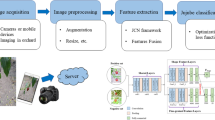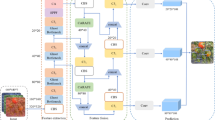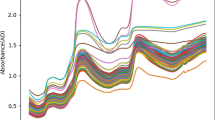Abstract
Jujube variety classification is a challenging task because of the difficulty in identifying discriminant features, making it difficult to find the subtle features that can fully represent the variety. Besides, jujube identification using single-organ fruit is not sufficiently reliable because different jujube varieties usually have similar fruit shape. To overcome these problems, this paper proposed an automatic jujube identification model based on attention mechanism by combining multiple organs of jujube. The model used a conventional neural network to perform feature extraction on images, and subsequently adopted some fusion techniques to further process the feature maps. By introducing the attention mechanism, the model could recalibrate channel and spatial characteristic responses adaptively so as to focus on the more discriminative regions of the images. Based on the idea of fusing multi-organ features, the network effectively obtained more significant cues for jujube recognition. Experimental results showed that the proposed network had a higher accuracy of 94.77% on jujube classification compared with other methods. It is demonstrated that the network was of great value to jujube recognition research.















Similar content being viewed by others
References
Bahdanau D, Cho K, Bengio Y (2014) Neural machine translation by jointly learning to align and translate. arXiv preprint arXiv 1409.0473. https://doi.org/10.48550/arXiv.1409.0473
Feichtenhofer C, Pinz A, Zisserman A (2016) Convolutional two-stream network fusion for video action recognition. In: Proceedings of the IEEE conference on computer vision and pattern recognition, pp 1933–1941
Fu J, Liu J, Tian H, Li Y, Bao Y, Fang Z, Lu H (2019) Dual attention network for scene segmentation. In: Proceedings of the IEEE/CVF conference on computer vision and pattern recognition, pp 3146–3154
Hameed AA, Karlik B, Salman MS (2016) Back-propagation algorithm with variable adaptive momentum. Knowl Based Syst 114:79–87. https://doi.org/10.1016/j.knosys.2016.10.001
He K, Zhang X, Ren S, Sun J (2016) Deep residual learning for image recognition. In: Proceedings of the IEEE conference on computer vision and pattern recognition, pp 770–778
Li L, Xu M, Wang X, Jiang L, Liu H (2019) Attention based glaucoma detection: a large-scale database and cnn model. In: Proceedings of the IEEE/CVF conference on computer vision and pattern recognition, pp 10571–10580
Liu M, Wang J, Wang L et al (2020) The historical and current research progress on jujube—a superfruit for the future. Hortic Res. https://doi.org/10.1038/s41438-020-00346-5
Liu MJ, Wang JR, Ping L, Zhao J, Zhao ZH, Li D, Li XS, Liu ZG (2015) Historical achievements and frontier advances in the production and research of chinese jujube (ziziphus jujuba) in china. Acta Hortic Sinica 42:1683
Lou H, Hu Y, Wang B, Lu H (2012) Dried jujube classifification using support vector machine based on fractal parameters and red, green and blue intensity. Int J of Food Sci Tech 47:1951–1957. https://doi.org/10.1111/j.1365-2621.2012.03055.x
Meng Q, Zhang W (2019) Multi-label image classifification with attention mechanism and graph convolutional networks. In: Proceedings of the ACM Multimedia Asia, pp 1–6 https://doi.org/10.1145/3338533.3366589
Meng X, Yuan Y, Teng G, Liu T (2021) Deep learning for fifine-grained classifification of jujube fruit in the natural environment. J Food Meas Charact 15:4150–4165. https://doi.org/10.1007/s11694-021-00990-y
Mnih V, Heess N, Graves A (2014) Recurrent models of visual attention. Adv Neural Inf Process Syst. https://doi.org/10.48550/arXiv.1406.6247
Paszke A, Gross S, Chintala S, Chanan G, Yang E, DeVito Z, Lin Z, Desmaison A, Antiga L, Lerer A (2017) Automatic difffferentiation in pytorch.
Srivastava N, Hinton G, Krizhevsky A, Sutskever I, Salakhutdinov R (2014) Dropout: a simple way to prevent neural networks from overfifitting. J Mach Learn Res 15:1929–1958. https://doi.org/10.5555/2627435.2670313
Woo S, Park J, Lee JY, Kweon IS (2018) Cbam: Convolutional block attention module. In: Proceedings of the European conference on computer vision (ECCV), pp 3–19
Xiang X, Yu Z, Lv N, Kong X, El Saddik A (2020) Semi-supervised image classifification via attention mechanism and generative adversarial network. In: Eleventh International Conference on Graphics and Image Processing (ICGIP 2019), pp 421–427
Xu K, Ba J, Kiros R, Cho K, Courville A, Salakhudinov R, Zemel R, Bengio Y (2015) Show, attend and Tell: neural image caption generation with visual attention. Comput Sci. https://doi.org/10.48550/arXiv.1502.03044
Yu Y, Xu L, Jia W, Zhu W, Fu Y, Lu Q (2020) CAM: A fine-grained vehicle model recognition method based on visual attention model. Image Vis Comput 104:104027. https://doi.org/10.1016/j.imavis.2020.104027
Zeiler MD, Fergus R (2014) Visualizing and understanding convolutional networks. In: Computer Vision–ECCV, pp 818–833 https://doi.org/10.1007/978-3-319-10590-1_53
Funding
This work was supported by Science and Technology Research Project of Colleges and Universities of Hebei Province (grant number ZC2023107), Industry-university-research Innovation Fund of the Ministry of Education (grant number 2021LDA12009) and Doctoral Start-up Fund of Shijiazhuang University (grant number 21BS017).
Author information
Authors and Affiliations
Corresponding author
Ethics declarations
Conflict of interest
Y. Song, J. Cao, Z. Liu, X. Meng, Y. Yuan and T. Liu declare that they have no competing interests.
Additional information
Publisher’s Note
Springer Nature remains neutral with regard to jurisdictional claims in published maps and institutional affiliations.
Rights and permissions
Springer Nature or its licensor (e.g. a society or other partner) holds exclusive rights to this article under a publishing agreement with the author(s) or other rightsholder(s); author self-archiving of the accepted manuscript version of this article is solely governed by the terms of such publishing agreement and applicable law.
About this article
Cite this article
Song, Y., Cao, J., Liu, Z. et al. Multi-organ Jujube Classification Based on a Visual Attention Mechanism. Applied Fruit Science (2024). https://doi.org/10.1007/s10341-024-01099-4
Received:
Accepted:
Published:
DOI: https://doi.org/10.1007/s10341-024-01099-4




